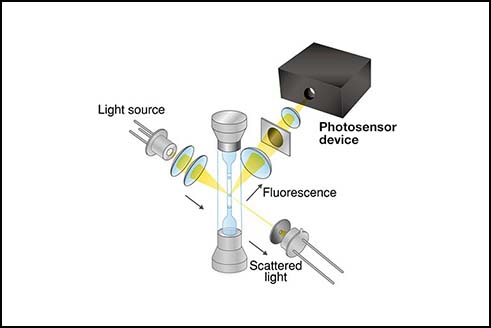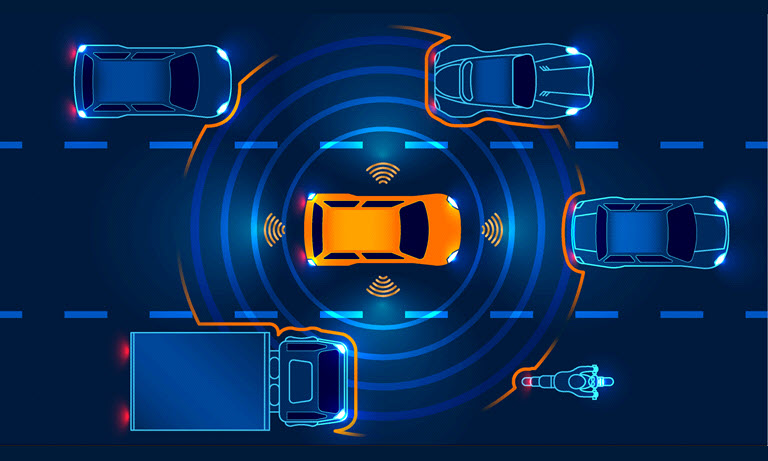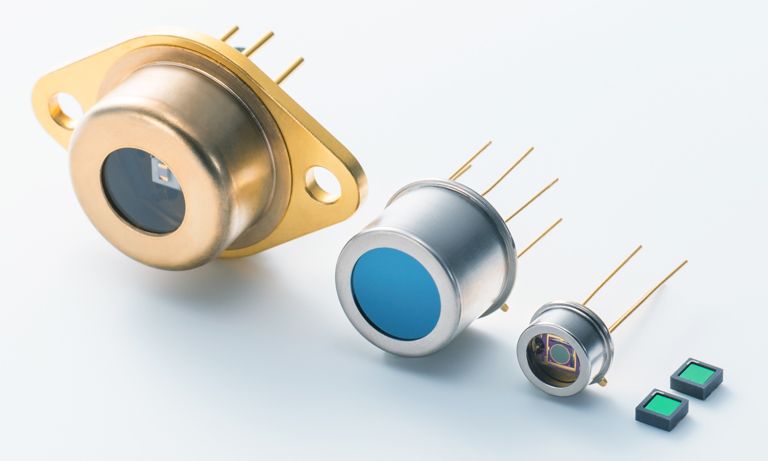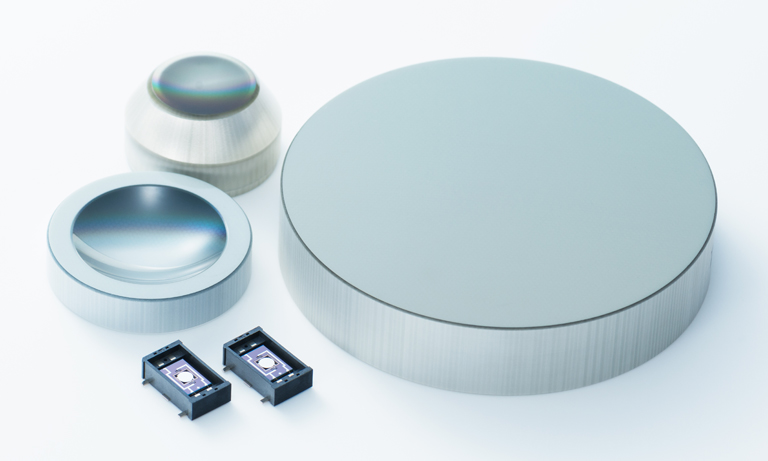Application notes
Technical notes
Ask an engineer
Publications
United States (EN)
Select your region or country.
A technical guide to silicon photomultipliers (MPPC) - Section 2
Ardavan Ghassemi, Hamamatsu Corporation
Kota Kobayashi & Kenichi Sato, Hamamatsu Photonics K.K.
January 11, 2018
2. APD & MPPC performance parameters
Each and every application that involves detection of light (regardless of its source: laser, LED, lamp, scintillation, different luminescence effects, etc.) can be defined and characterized by the following parameters.
2-1. Signal
An optical application’s input signal level is simply the amount of light that is to be detected. The input light signal has a spectral distribution, which is typically represented in simplistic calculations (such as the methods to be described here) by the peak wavelength. In quantifying the amount of input signal, the dimension or unit of measurement is essential for making proper calculations. The two dimensions that could be used by the methods described in this manual are Watts [W] and number of photons. Note that the former is normalized to time while the latter is not (although the latter could be, and both can be normalized to illumination area). A signal level S expressed in either of these units can be converted to the other by the following formula:
in which λ is the light wavelength of interest, T is illumination time for one measurement reading, h is Planck’s constant, and c is the speed of light. There are other units (lm, lx, etc.) used to express the amount of light present, but those units require tabulated reference data or complex calculations for their proper use, and hence, they are not discussed here as they exceed the intended scope of our discussion. Input light signal can be converted to output signal of a photodetector by the following relationship:
in which Sdark is the detector output charge that is not generated as a result of the photoelectric effect during the measurement, M is gain, and CE is collection efficiency.
Often, Photon Detection Efficiency (as defined by PDE = QE × CE) is used as part of equation 2-2; in the case of MPPC, CE = avalanche probability × fill factor (in which fill factor is the ratio of a MPPC pixel’s photosensitive area to the pixel’s total area). In the case of a fully-depleted APD, CE can be assumed to be 1.
2-2. Noise
The intrinsic uncertainty or random fluctuation in a measured signal is noise. For an optical signal, noise is characterized through a histogram (a so-called pulse height distribution or PHD) of incidents of detected light pulses with varying heights (corresponding to differing counts of photons); the resulting histogram could be closely fitted into a profile similar to that of a Poisson probability distribution. That leads us to conclude that noise characteristics of a photon signal can be modeled by the following Poisson probability distribution function and its corresponding mean (μ) and standard deviation (σ) with m being the expected number of detected photons on average:
To model the detection of light using the above probability model, the standard deviation is considered a measure of randomness or uncertainty (i.e. noise) of the Poisson random variable (i.e. photon signal), and the mean is the expected value of the signal. In other words, intrinsic noise of a light signal is described by the square root of its mean. A photodetector’s dark output also has a Poisson probability distribution. A noise whose random behavior can be characterized by a Poisson distribution is often referred to as shot noise.
2-3. Signal-to-noise ratio (S/N)
As its name suggests, it is the ratio of signal to noise as calculated for a detector’s output. In light detection applications with unity gain, it is fundamentally defined by:
in which nphoton shot is the photon shot noise, ndark shot is the dark shot noise, and nreadout is the readout noise generated by the output amplifier circuit (at its bandwidth frequency). More practically, considering that APDs are typically read out in analog (linear) mode, there are two S/N equations for APDs:
i. when read out by resistive trans-impedance amplifiers for relative measurements:
in which q is the fundamental electron charge, Δf is readout amplifier bandwidth, JTN is Johnson thermal noise, and Φ = QE・λ / 124000 is APD unity-gain photosensitivity [A/W] in whose calculation QE is a percentage and λ is wavelength [nm]. is a Gaussian noise component that originates from thermal generation of current in the APD’s load resistor (even without any external voltage applied across it). In JTN’s calculation, is typically assumed, and thus, it can be simplified to or for room temperature and could hence be ignored for relatively low frequencies or if other noise factors or the signal are comparatively large. Additionally, considering that tends to be small compared to other components of the denominator, equation 2-5 can be further simplified to:
In equations 2-5 and 2-6, Sinput is in the unit of W, and Sdark is in the unit of A and includes the multiplication effect of APD gain.
ii. when read out by capacitive trans-impedance amplifiers (a.k.a. charge amplifiers) for photometric or absolute measurements:
in which M is gain and F = Mx is APD excess noise factor for whose calculation x is provided as excess noise index in Hamamatsu APD datasheets (for a certain illumination wavelength but yet a reasonable generalized estimation for our purpose). In equation 2-7, Sinput is in the unit of photons, and Sdark is in the unit of electrons.
It is noteworthy that both equation 2-5 and equation 2-7 become applicable to PN and PIN photodiodes by setting M = 1 and F = 1.
It is also noteworthy to mention that since the inverse of the integration time of a charge amplifier would represent its max. sampling rate, and considering that measurement bandwidth would be half of the sampling rate based on Nyquist’s theorem, the denominator of equation 2-7 lacks the factor 2 that exists in the denominator of equations 2-5 and 2-6 as both Sinput and Sdark would be accumulated over the charge amplifier’s integration time.
In the case of MPPC, considering the binary nature of the readout scheme in photon counting, readout noise is forgone, and the following equation3 would be used per measurement reading:
in which Nphoton is the number of photons incident onto the MPPC, (Nphoton x PDE) is the number of photoelectrons detected and Ndark is the MPPC dark (up to 1 p.e. in height under no illumination) output pulse count during a measurement. The latter portion of equation 2-8 is particularly useful in experimental determination of photon-counting S/N with Ntotal being obtained from dividing the MPPC’s total output charge by the amount of output charge corresponding to 1 p.e. pulse height. As we will discuss in section 4, these counts would be calculated by performing PHD analysis on integrated MPPC output pulse data. Keep in mind that equation 2-8 is simplistic as it assumes no correlated noise, but considering the greatly diminished levels of crosstalk and afterpulsing in Hamamatsu’s MPPCs (down to few %) as mentioned in the previous section, it is a practical approximation. Please bear in mind that equations 2-4 to 2-8 assume that the signal to be measured is the only light flux incident on the detector (i.e. no background light).
3 The derivation of the denominator of equation 2-8’s second half is often a point of curiosity. If we define (T – D) as a random variable to be the photo-signal (i.e. Dark-subtracted Total output signal measured under illumination), then its variance would be: . Since total output signal and dark signal are uncorrelated, we have: . Thus, RMS combination of shot noises of dark signal and photo-signal becomes:
2-4. Linearity
The extent to which the output of a photodetector has a linear relationship with its input (as defined by f(x) = b.x + c in which b and c are real constants) is the measure of a photodetector’s linearity and is fundamentally defined by:
in which A is signal amplitude and t represents passage of time. If the ratio of the 2 relative changes is < 1, nonlinearity exists. For practical purposes, nonlinearity is typically of greater interest than linearity itself:
Since ideal photodetector response is theoretically linear (within the constraints of S/N > 1 and up to saturation), linearity can be practically obtained by:
In terms of detector response, there are 3 particular definitions of linearity:
- DC linearity: This is a measure of how mean output of a detector changes linearly with respect to changes in average light input over a period of time. Understanding the concept of ‘DC’ linearity within the context of an average over a single measurement’s time duration is important: linearity can be feasibly assessed by relying on data points of mean response (integrated during each measurement reading and thus averaged per its time duration) for signals with randomly fluctuating amplitudes or nonharmonic repetitions.
- Pulse height (or amplitude) linearity: This is the relative extent by which a change in an input light pulse’s amplitude results in a change in the photodetector’s output. For APDs, this linearity is limited by saturation effect of the junction capacitance’s rate of charge-up and discharge as influenced or further limited by the readout circuitry.
In the case of MPPC, upper linearity limit is characterized by availability of pixels to detect succeeding photons while a portion of the pixel population is recovering from the detection of the preceding photons. While ideal MPPC response is theoretically linear as defined by:
MPPC’s real response can be predicted with high accuracy by:
in which Nfired is the number of MPPC pixels fired (i.e. undergoing Geiger-mode avalanche) by the incident photons, Npixel is the number of MPPC’s pixels, Nphoton is the number of incident photons per light pulse, PW is the width of the incident light pulse, and Trecovery is the recovery time of a MPPC pixel.
- Pulse rate linearity (Detector bandwidth): This is a measure of a photodetector’s pulse height linearity as a function of input signal pulse rate. Ideally, there must be no dependence; however, in practice, an undesirable effect known as pulse pileup occurs with output pulse heights (i.e. output signal level differences between peaks and valleys of pulses) decreasing as frequency increases to exceedingly higher levels.
For a fixed readout impedance, pulse rate linearity is limited by a detector’s internal capacitance. For a pulsed input signal of fixed amplitude but increasing frequency, bandwidth is defined as the frequency [Hz] at which amplitudes of output pulses decline by a certain amount compared to a DC input signal of the same amplitude. In APD’s case, response bandwidth is considered to be limited by a cutoff response frequency defined by:
for which RL = 50 Ω is typically assumed.
Bandwidth is a concern in the design of output amplifier circuits and other readout electronics, considering that a larger amplifier bandwidth allows the passage of a wider spectrum of noise frequency components to the output while bandwidth must be larger than the highest-frequency component of the input light signal in order to allow its proper detection. Thus, the designer of a detector system seeks to select a detector with a cutoff frequency that is by a conservative margin above the highest-frequency component of the signal and then design a readout amplifier circuit whose bandwidth is also by a conservative margin above the highest-frequency component of the signal.
In a pulsed application, if the study of individual light pulses is intended for instance, the signal’s highest-frequency component is the product of the constant 0.35 and the inverse of the shortest pulse rise or fall time (10% to 90% or vice versa of amplitude) that is to be measured.
Furthermore, the readout amplifier circuit’s cutoff frequency at -3 dB should be designed to be at least twice that of the signal’s highest-frequency component whose measurement is desirable (but as a general rule of thumb, 4 times is an advisable design target).
Assessing MPPC pulse-rate linearity is a complex computational effort that is beyond the scope of this manual; however, if the expected time interval between 2 consecutive light pulses will be longer than Trecovery, the application is within the pulse-rate linearity range of the MPPC. If not, that does not necessarily mean that the application exceeds the MPPC’s pulse-rate linearity, but complex simulation or actual experimentation would be needed in order to assess that.
2-5. Dynamic range (DR)
DR is typically expressed as a ratio between two levels of the input signal. One level (as numerator of the ratio) is the highest amount of input signal at which the detector maintains its response linearity (i.e. nonlinearity < application’s requirement). The other (denominator of the ratio) is the lowest amount of input signal at which the detector behaves linearly.
Over a detector’s DR, nonlinearity at the lower limit is typically limited by noise (whether dark or readout noise or a combination thereof), or in other words, the amount of input signal that yields S/N = 1 (often measured and divided by square root of the bandwidth and then specified as noise-equivalent power ). On the other hand, nonlinearity at DR’s upper limit is typically caused by saturation effects.
As represented by a photodetector’s rise and fall times, this is an indicator of how closely the output of a photodetector temporally resembles the shape of its input. That is particularly important for applications in which maintaining the pulse shape integrity of the input signal is desirable for pulse shape discrimination (PSD); in those cases, the detector’s rise and fall times must be shorter than rise/fall times of input light pulses. A fully-depleted silicon photodetector’s rise time is dominated by carrier drift time within its depletion layer while its fall time is proportional to its capacitance (for a fixed readout impedance).
2-6. Time response
As represented by a photodetector’s rise and fall times, this is an indicator of how closely the output of a photodetector temporally resembles the shape of its input. That is particularly important for applications in which maintaining the pulse shape integrity of the input signal is desirable for pulse shape discrimination (PSD); in those cases, the detector’s rise and fall times must be shorter than rise/fall times of input light pulses. A fully-depleted silicon photodetector’s rise time is dominated by carrier drift time within its depletion layer while its fall time is proportional to its capacitance (for a fixed readout impedance).
2-7. Time resolution
The uncertainty that exists in determining the timing of a detected event with respect to a reference point in time (which could be another detected event) is called time resolution. In optical applications, that is the overall uncertainty in timing the detection of an input light pulse and is fundamentally defined by:
In this formula, pulse timing is that aspect of the detector’s output pulse that is used for determining its detection time. For example, if the time measurement system is edge-triggered, pulse timing would be a portion of the rise time of the pulse (depending on the trigger’s set threshold). On the other hand, if level-triggered, pulse timing would be the time duration of that portion of the pulse shape that defines level. In how the photodetector output signal is amplified and used for triggering, fluctuations in the formation of this timing parameter (called amplitude time walk) cause a variance in measuring time.
On the other hand, time stamping is the recording of the signal’s timing by the measurement system once the trigger requirement has been met; this parameter also experiences a variance (typically due to digitization noise of the measurement system).
However, since caused by the photodetector alone and as the limiting factor of the overall time resolution of a light detection system, detector jitter is the parameter of interest to our discussion. Considering the Poisson nature of photoelectron signal and noise, we can conclude that the jitter is proportional to the inverse of the square root of the number of photoelectrons:
∝
This relationship provides a highly effective tool in preliminary technical considerations, but one must understand its limitation: it is only applicable to timing at point of charge generation and excludes any variability in delays that might be present in charge collection and readout.
- Confirmation
-
It looks like you're in the . If this is not your location, please select the correct region or country below.
You're headed to Hamamatsu Photonics website for US (English). If you want to view an other country's site, the optimized information will be provided by selecting options below.
In order to use this website comfortably, we use cookies. For cookie details please see our cookie policy.
- Cookie Policy
-
This website or its third-party tools use cookies, which are necessary to its functioning and required to achieve the purposes illustrated in this cookie policy. By closing the cookie warning banner, scrolling the page, clicking a link or continuing to browse otherwise, you agree to the use of cookies.
Hamamatsu uses cookies in order to enhance your experience on our website and ensure that our website functions.
You can visit this page at any time to learn more about cookies, get the most up to date information on how we use cookies and manage your cookie settings. We will not use cookies for any purpose other than the ones stated, but please note that we reserve the right to update our cookies.
1. What are cookies?
For modern websites to work according to visitor’s expectations, they need to collect certain basic information about visitors. To do this, a site will create small text files which are placed on visitor’s devices (computer or mobile) - these files are known as cookies when you access a website. Cookies are used in order to make websites function and work efficiently. Cookies are uniquely assigned to each visitor and can only be read by a web server in the domain that issued the cookie to the visitor. Cookies cannot be used to run programs or deliver viruses to a visitor’s device.
Cookies do various jobs which make the visitor’s experience of the internet much smoother and more interactive. For instance, cookies are used to remember the visitor’s preferences on sites they visit often, to remember language preference and to help navigate between pages more efficiently. Much, though not all, of the data collected is anonymous, though some of it is designed to detect browsing patterns and approximate geographical location to improve the visitor experience.
Certain type of cookies may require the data subject’s consent before storing them on the computer.
2. What are the different types of cookies?
This website uses two types of cookies:
- First party cookies. For our website, the first party cookies are controlled and maintained by Hamamatsu. No other parties have access to these cookies.
- Third party cookies. These cookies are implemented by organizations outside Hamamatsu. We do not have access to the data in these cookies, but we use these cookies to improve the overall website experience.
3. How do we use cookies?
This website uses cookies for following purposes:
- Certain cookies are necessary for our website to function. These are strictly necessary cookies and are required to enable website access, support navigation or provide relevant content. These cookies direct you to the correct region or country, and support security and ecommerce. Strictly necessary cookies also enforce your privacy preferences. Without these strictly necessary cookies, much of our website will not function.
- Analytics cookies are used to track website usage. This data enables us to improve our website usability, performance and website administration. In our analytics cookies, we do not store any personal identifying information.
- Functionality cookies. These are used to recognize you when you return to our website. This enables us to personalize our content for you, greet you by name and remember your preferences (for example, your choice of language or region).
- These cookies record your visit to our website, the pages you have visited and the links you have followed. We will use this information to make our website and the advertising displayed on it more relevant to your interests. We may also share this information with third parties for this purpose.
Cookies help us help you. Through the use of cookies, we learn what is important to our visitors and we develop and enhance website content and functionality to support your experience. Much of our website can be accessed if cookies are disabled, however certain website functions may not work. And, we believe your current and future visits will be enhanced if cookies are enabled.
4. Which cookies do we use?
There are two ways to manage cookie preferences.
- You can set your cookie preferences on your device or in your browser.
- You can set your cookie preferences at the website level.
If you don’t want to receive cookies, you can modify your browser so that it notifies you when cookies are sent to it or you can refuse cookies altogether. You can also delete cookies that have already been set.
If you wish to restrict or block web browser cookies which are set on your device then you can do this through your browser settings; the Help function within your browser should tell you how. Alternatively, you may wish to visit www.aboutcookies.org, which contains comprehensive information on how to do this on a wide variety of desktop browsers.
5. What are Internet tags and how do we use them with cookies?
Occasionally, we may use internet tags (also known as action tags, single-pixel GIFs, clear GIFs, invisible GIFs and 1-by-1 GIFs) at this site and may deploy these tags/cookies through a third-party advertising partner or a web analytical service partner which may be located and store the respective information (including your IP-address) in a foreign country. These tags/cookies are placed on both online advertisements that bring users to this site and on different pages of this site. We use this technology to measure the visitors' responses to our sites and the effectiveness of our advertising campaigns (including how many times a page is opened and which information is consulted) as well as to evaluate your use of this website. The third-party partner or the web analytical service partner may be able to collect data about visitors to our and other sites because of these internet tags/cookies, may compose reports regarding the website’s activity for us and may provide further services which are related to the use of the website and the internet. They may provide such information to other parties if there is a legal requirement that they do so, or if they hire the other parties to process information on their behalf.
If you would like more information about web tags and cookies associated with on-line advertising or to opt-out of third-party collection of this information, please visit the Network Advertising Initiative website http://www.networkadvertising.org.
6. Analytics and Advertisement Cookies
We use third-party cookies (such as Google Analytics) to track visitors on our website, to get reports about how visitors use the website and to inform, optimize and serve ads based on someone's past visits to our website.
You may opt-out of Google Analytics cookies by the websites provided by Google:
https://tools.google.com/dlpage/gaoptout?hl=en
As provided in this Privacy Policy (Article 5), you can learn more about opt-out cookies by the website provided by Network Advertising Initiative:
http://www.networkadvertising.org
We inform you that in such case you will not be able to wholly use all functions of our website.
Close















